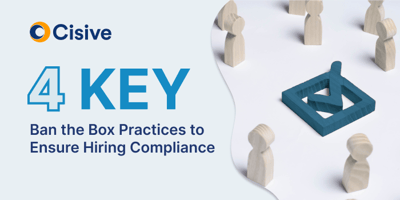

“Ban the box” laws have existed for more than 20 years and have taken effect across dozens of...

The hiring process can be time-consuming and expensive, so companies want to ensure their investment leads to hiring the best candidate. However, attracting and hiring the “best” candidate must be done in ways consistent with fair hiring practices.
You can only remove unconscious bias from recruiting efforts by understanding fair hiring practices. If bias creeps in, you could be out of compliance with employment laws and regulations. That could lead to fines or lawsuits.
In this article, we highlight ways to build fair hiring practices into your recruitment and hiring processes.
Key TakeawaysHere are the key things you need to know about fair hiring practices:
|
The idea behind fair hiring practices is that employers should hire people based on their ability to do the job, not on personal traits. In other words, hiring must be based on skills and qualifications. You cannot hire (or not hire) due to factors like ethnicity, religion, gender, age, disability, sexual orientation, criminal history, or other characteristics.
Fair hiring practices encourage companies to build diverse workforces. Diversity has proven benefits, including improved company reputation and increased employee satisfaction, creativity, and innovation.
While fair hiring practices are certainly designed to reduce overt, intentional discrimination, they also help companies overcome unconscious bias. Learn more about reducing unconscious hiring bias.
Make strides toward fair hiring by learning these seven essential practices.
Federal laws to increase fair hiring cover all aspects of employment, including hiring. They can affect job descriptions, advertising, interviewing, and background checking.
These job discrimination laws include Title VII of the Civil Rights Act (EEOC-Green Factors), the Equal Pay Act, the Age Discrimination in Employment Act, the Americans with Disabilities Act, and the Pregnant Workers Fairness Act.
The Equal Employment Opportunity Commission (EEOC) is the federal agency that enforces these laws. Job applicants can file EEOC complaints against companies, requiring the company to spend tens of thousands of dollars defending itself. If the EEOC gives the applicant permission to file a lawsuit, the cost to the business can skyrocket.
Avoiding the time and expense of court battles is one reason to make sure you follow fair hiring practices.
Reducing bias in hiring, especially unconscious bias, requires implementing certain strategies.
Anonymous or blind resumes are created by removing things like names, birth dates, zip codes, and hobbies. The goal is to remove any data unrelated to skills and qualifications. This keeps the focus on work-based attributes and reduces the chance that an HR employee or hiring manager would choose a candidate due to personal characteristics.
Have a prepared set of job-related questions that recruiters ask all candidates. Don’t let recruiters veer into asking subjective questions that are not on the script.
AI can assist you in writing bias-free job ads, removing irrelevant details from resumes, and screening applications. Thoughtfully integrating AI into your processes can also free up time for your employees, who will have the freedom to do more valuable tasks than manually reviewing resumes. However, as rapidly moving and advancing as “artificial Intelligence” technology is in the workplace, so too are the laws and regulations around the use of AI, always review your hiring policies and practices with legal counsel to help ensure compliance.
Often, job descriptions are written with gender-coded, biased language. Use of such language is mostly unintentional, but it can dissuade diverse populations of people from applying.
To write inclusive job ads, be aware of gender-coded terms and substitute neutral wording. Here are some examples:
There are other, more subtle ways your postings can be unintentionally biased. For example, certain words are known to turn off some candidates, such as “aggressive” and “strong.” Reading those words might make some people avoid applying because the words could suggest a male-dominated culture.
If your company has a stated commitment to diversity and inclusion, include that in your job postings. Publicly sharing this commitment can show potential applicants that the company values and embraces fair hiring practices.
By writing inclusive job ads, you will be helping your company create a more diverse applicant pool and a more diverse workforce.
Companies expect honesty from applicants, and applicants have a right to expect the same from employers. Being transparent about your hiring process fosters trust between you and the candidate.
Communication is the key to transparent hiring. This starts with a well-crafted job description that spells out the role’s responsibilities, required skills, educational requirements, and other qualifications. Clear communication must be carried over when talking to candidates through every hiring step.
Transparency also means disclosing the job’s salary range. Including salary information in job postings is a legal requirement in a growing number of states. Forward-thinking companies include this information in their postings, even if it’s not legally required. This saves the company and the candidate time by ensuring they are on the same page from the start.
You should also communicate timelines. This includes the number of interviews, the time required for background checks, and how long you expect the hiring process to take. This helps reduce the need for candidates to continually ask for updates regarding their application process with your company.
Anyone involved in the recruiting and hiring process should have access to training to help them refine their approach and stay aware of evolving laws. This includes not only your HR team but also hiring managers and company leaders.
Training sessions can be built around many different topics. Important subjects are ones like unconscious bias, employment law in general, anti-discrimination laws, and examples of unfair hiring practices.
Training can be done using a variety of methods. An expert could provide in-person sessions, or you could record sessions and distribute them to employees. You can also purchase training videos and have employees complete them in an online learning center.
Staying up to date not only keeps you compliant, but also helps you take advantage of new processes and approaches to hiring. Plan to have regular training sessions for your team, minimally annually.
Establishing fair hiring practices is not a set-it-and-forget-it proposition. Laws change, society evolves, and expectations do, too. You should continuously monitor your hiring practices to make sure they are fair today and tomorrow.
One important way to evaluate your hiring is to use data analytics. Review the diversity of the applicants who have applied for certain jobs and monitor how it changes through hiring to the final selection. These statistics can help you identify areas in your process that may inadvertently be portraying bias.
It’s a good idea to set up regular meetings with HR and hiring managers to discuss what you find during your process evaluations. Discuss ways to update your recruiting process to ensure it remains inclusive. Ultimately, doing so will improve your reputation as a great employer and help you attract the best candidates.
Your applicant tracking system (ATS) can provide insight into many aspects of your talent acquisition efforts. The analytics in your ATS can help you see how long it takes to hire, where candidates came from, how many candidates were disqualified, and more. You can also get insights into the diversity of your applicant pool. If it lacks diversity, you can take steps to improve your process.
Diversity recruiting software is also helpful. Such software analyzes information to find candidates with varying backgrounds that fit your job needs, and it does so without unconscious bias. Diversity recruiting software helps you build a diverse talent pool and improve your diversity, equity, and inclusion efforts.
Fair hiring practices are legal requirements but implementing them is about more than just staying out of trouble. By creating a genuinely fair, unbiased recruitment process, you can increase diversity in your workforce, boost innovation, set your company up for growth, and make your company an employer that people aspire to work for.
For more insights and advice about improving your hiring practices, reach out to the Cisive team.
Author: Michael Kendrick
Bio: Director of Corporate Legal/Compliance at Cisive.
Let's Connect on LinkedIn
“Ban the box” laws have existed for more than 20 years and have taken effect across dozens of...

You've probably felt the pressure to hire quickly. At the same time, you’re managing interviews,...

Expanding your business internationally can be a great growth opportunity, but it comes with the...